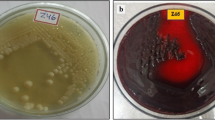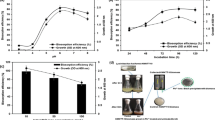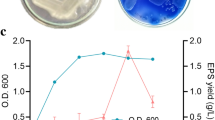Abstract
Four strains (Enterobacter sp. EnHy-401, Arthrobacter sp.ArHy-505, Azotobacter sp.AzHy-510 and Enterobacter sp.EnHy-402) which have the ability to solubilize tricalcium phosphate (TCP) were used to study the mechanism of P-solubilization. It was found that three phosphate solubilizing bacteria (EnHy-401, ArHy-505 and AzHy-510) producing exopolysaccharide (EPS) have a stronger ability for P-solubilization than isolate EnHy-402 without EPS production, of those, the strain EnHy-401 with the highest EPS production and efficient organic acids on P-solubilization had a stronger capacity for P-solubilization than the others. Further studies demonstrated that addition of EPS into medium could increase the amount of phosphorus solubilized by organic acid, but failed to release phosphorus from TCP alone. The synergistic effects of EPS and organic acid on TCP solubilization varied with the origin and the concentration of EPS in medium. EPS produced by EnHy-401 was most effective in promoting phosphorus release at an optimal concentration in medium. The increase of P-solubilization brought by EPS attributed to the participation of EPS led to the change in homeostasis of P-solubilization, pushing it towards P dissolved by holding free phosphorus in the medium, consequently resulting in greater phosphorus released from insoluble phosphate. We therefore suggest that EPS with ability of phosphorus-holding may be a novel important factor in the microbial dissolution of TCP except for organic acid.




Similar content being viewed by others
Abbreviations
- P:
-
Phosphate
- TCP:
-
Tricalcium phosphate
- EPS:
-
Exopolysaccharide
- PSB:
-
Phosphate solubilizing bacteria
- PSM:
-
Phosphate solubilizing microorganism
- NBRIP:
-
National Botanical Research Institute’s phosphate growth medium
References
Asea PEA, Kucey RM, Stewart JWB (1988) Inorganic phosphate solubilization by two Penicillium species in solution culture and soil. Soil Biol Biochem 20:459–464
Bnayahu BY (1991) Root excretions and their environmental effects: influence on availability of phosphorus. In: Waisel Y, Eshel A, Kafkafi U (eds) Plant roots: the hidden half. Marcel Decker, New York pp 529–557
Benedetti LM, Topp E, Stella VJ (1989) A novel drug delivery system: microspheres of hyaluronic acid derivatives. In: Sutherland IW (ed) Biomedical and biotechnological advances in industrial polysaccharides. Gordon and Breach, New York, NY, pp 27–33
Chen YP, Rekha PD, Arun AB, Shen FT, Lai WA, Young CC (2006) Phosphate solubilizing bacteria from subtropical soil and their tricalcium phosphate solubilizing abilities. Appl Soil Ecol 34:33–41
Duff RB, Webley DM (1959) 2-Ketogluconic acid as a natural chelator produced by soil bacteria. Chem Ind 1376–1377
Goldstein AH (1994) Involvement of the quinoprotein glucose dehydrogenase in the solubilization of exogenous phosphates by gram-negative bacteria. In: Torriani-Gorini A, Yagil E, Silver S (eds) Phosphate in microorganisms: cellular and molecular biology. ASM Press, Washington, DC, pp 197–203
Goldstein AH (1995) Recent progress in understanding the molecular genetics and biochemistry of calcium phosphate solubilization by Gram negative bacteria. Biol Agric Hort 12:185–193
Gong LD, Xu QQ (1990) GB/T 12456-90 Method for determination of total acid in foods (S). Chinese Standard Press, Beijing, P.R. China
Gutnick D (1997) Engineering polysaccharides for biosorption of heavy at oil/water interfaces. Res Microbiol 148:519–521
Halder AK, Mishra AK, Bhattacharyya P, Chakrabartty PK (1990) Solubilization of rock phosphate by Rhizobium and Bradyrhizobium. J Gen Appl Microbiol 36:81–92
Holt JG, Krieg NR, Sneath PHA, Staley JT, Williams ST (eds) (1994) Genus pseudomonas. In: Bergey’s manual of determinative bacteriology, 9th edn. Williams & Wilkins, Baltimore pp 93–94
Hopkins CG, Whiting AL (1916) Soil bacteria and phosphates. III. Agric Exp Stn Bull 190:395–406
Illmer P, Schinner F (1992) Solubilisation of inorganic phosphates by microorganisms isolated from forest soils. Soil Biol Biochem 24:389–395
Illmer P, Schinner F (1995) Solubilization of inorganic calcium phosphates solubilization mechanisms. Soil Biol Biochem 27:257–263
Isberword KF (1998) Fertilizer use and environment. In: Ahmed et al (eds) Proceedings of Symposium: plant nutrition management for sustainable agricultural growth. Pakistan, pp 57–76
Kim KY, Jordan D, Krishnan HB (1997a) Rahnella aqualitis, a bacterium isolated from soybean rhizosphere, can solubilize hydroxyapatite. FEMS Microbiol Lett 153:273–277
Kim KY, McDonald GA, Jordan D (1997b) Solubilization of hydroxypatite by Enterobacter agglomerans and cloned Escherichia coli in culture medium. Biol Fertil Soils 24:347–352
Kpomblekou K, Tabatabai MA (1994) Effect of organic acids on release of phosphorus from phosphate rocks. Soil Sci 158:442–451
Lin QM, Wang H, Zhao XR, Zhao ZJ (2001) Capacity of some bacteria and fungi in dissolving phosphate rock(in Chinese). Microbiology 28(2):26–30
Lu RK, Jiang BF, Xiong Y (1990) Soils of China (in Chinese), Second edition. Science Press, Beijing, P.R. China, pp 483–510
Morgante C, Castro S, Fabra A (2007) Role of rhizobial EPS in the evasion of peanut defense response during the crack-entry infection process. Soil Biol Biochem 39:1222–1225
Murphy J, Riley JP (1962) A modified single solution method for the determination of phosphate in natural waters. Anal Chim Acta 27:31–36
Nautiyal CS (1999) An efficient microbiological growth medium for screening phosphate solubilizing microorganisms. FEMS Microbiol Lett 170:265–270
Paul NB, Sundama Rao WVB (1971) Phosphate dissolving bacteria in the rhizosphere of some cultivate legumes [J]. Plant Soil 35:127–132
Raghothama KG (2000) Phosphorus acquisition: plant in the driver’s seat. Trends Plant Sci 5(10):412–413
Shao ZC, Zhao MZ (2002) Activation kinetics of accumulative phosphorus in soils II. The effects of zeoli. Chinese J Soil Sci (in Chinese) 33:121–123
Sperberg JI (1958) The incidence of apatite-solubilizing organisms in the rhizosphere and soil. Aust J Agric Res 9:778
Stevenson FJ (1967) Organic acids in soil. In: McLaren AD, Peterson GH (eds) Soil biochemistry. Marcel Decker, New York, pp 130–146
Stevenson FJ (1986) Cycles of soil, carbon, nitrogen, phosphorus, sulfur, micronutrients. John Wiley, New York
Sundara B, Natarajan V, Hari K (2002) Influence of phosphorus solubilizing bacteria on the changes in soil available phosphorus and sugarcane and sugar yields. Field Crops Res 77:43–49
Sutherland IW (1996) Products of primary metabolism. In: Reed G (ed) Biotechnology. Wiley–VCH, Weinheim, Germany, pp 613–657
Wang QR, Li JY, Li ZS (1998) Dynamics and prospect on study of high acquisition of soil unavailable phosphorus by plants. Plant Nutr Fertil Sci (in Chinese) 4(2):107–116
Whitelaw MA, Harden TJ, Bender GL (1997) Plant growth promotion of wheat inoculated with Penicillium radicum sp. nov. Aust J Soil Res 35:291–300
Wilson KH, Blitchington RB, Greene RC (1990) Amplification of bacterial 16S ribosomal DNA with polymerase chain reaction. J Clin Microbiol 28:1942–1946
Woese CR, Fox GE, Zablen L et al (1975) Conservation of primary structure in 16S ribosomal RNA. Nature 254:83–86
Zhang YS, Lin XY, Luo AC (1998a) Studies on activation of phosphorus by organic manure in soils and its mechanisms, I. Organic acids from decomposition of organic manure (matter) and their effect on activation to different artificial phosphate. Plant Nutr Fertil Sci (in Chinese) 4(2):151–155
Zhang YS, Lin XY, Luo AC, Su L (1998b) Effect of organic manure (matter) on activation to different phosphate in soils. Plant Nutr Fertil Sci (in Chinese) 4(2):145–150
Zhao XR, Lin QM, Li BG (2002) The solubilization of four insoluble phosphates by some microorganisms (in Chinese). Acta Microbiol Sin 42:236–241
Acknowledgements
The authors thank Mr. Liu Zilie (Nanjing Normal University, China) to help HPLC analysis of the organic acid in this study.
Author information
Authors and Affiliations
Corresponding author
Rights and permissions
About this article
Cite this article
Yi, Y., Huang, W. & Ge, Y. Exopolysaccharide: a novel important factor in the microbial dissolution of tricalcium phosphate. World J Microbiol Biotechnol 24, 1059–1065 (2008). https://doi.org/10.1007/s11274-007-9575-4
Received:
Accepted:
Published:
Issue Date:
DOI: https://doi.org/10.1007/s11274-007-9575-4




